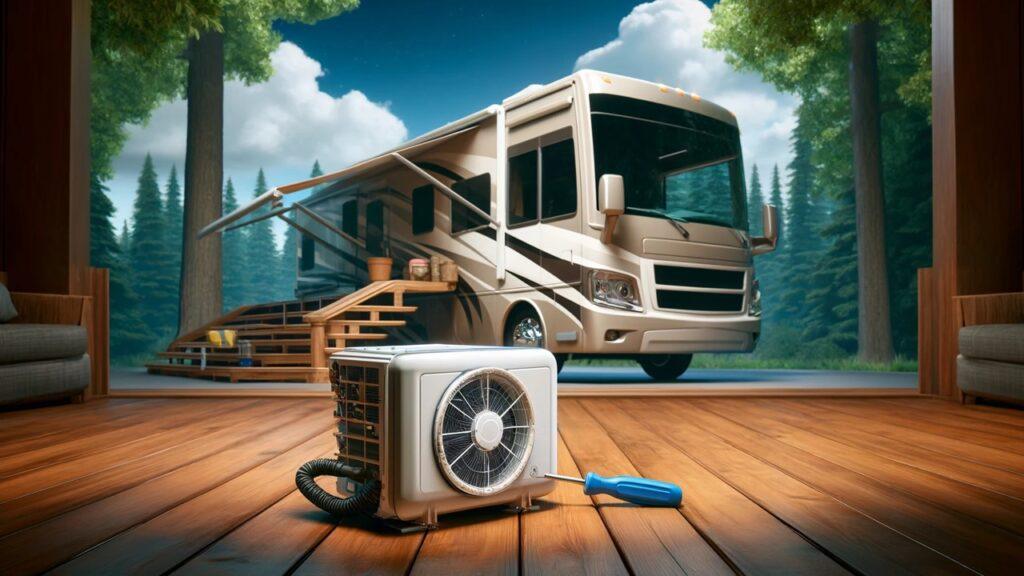
Maintaining the Air Conditioning unit of your RV is crucial for ensuring comfort during your travel adventures. Refrigerant leaks can significantly undermine this comfort, leading to inefficient cooling and potentially costly repairs. Furthermore, these leaks pose environmental risks, releasing gases that could harm the ecosystem. In our guide, “How To Handle Refrigerant Leaks In Your RV Air Conditioning Unit,” we delve into effective strategies for RV maintenance and repair, helping you safeguard your system against such issues. Moreover, understanding the impact of these leaks will equip you to address them promptly, maintaining optimal performance and longevity of your Camper Van’s air conditioning system.
Identifying and Understanding Refrigerant Leaks in RV Air Conditioners
Detecting and addressing refrigerant leaks in your RV air conditioner is pivotal to ensuring a comfortable and efficient journey. By understanding the common causes and recognizing the symptoms early, you can take proactive steps to mitigate damage and maintain the integrity of your system. In this section, we explore the origins of these leaks and how to spot them, ensuring your RV remains a cool refuge during your travels.
Common Causes of Refrigerant Leaks
Refrigerant leaks in an RV’s air conditioning system often stem from several factors. Normal wear and tear is a frequent culprit, as vibrations and constant movement from travel can loosen fittings and erode seals. Furthermore, environmental factors such as extreme temperatures and corrosion due to moisture exposure can degrade components over time. Understanding these triggers helps in preempting potential issues, keeping your system robust and responsive.
Recognizing The Signs of a Leak
Identifying the signs of a refrigerant leak early can save you significant time and expense. Watch for reduced cooling efficiency, a telltale sign that your RV might be low on refrigerant. Additionally, unusual hissing sounds or the presence of an oily residue near the air conditioning unit are clear indicators of a problem. Timely recognition of these symptoms enables quick interventions, potentially averting more severe damage.
After exploring the origins and symptoms of refrigerant leaks, it’s clear that regular checks are essential. For those considering upgrades or replacements, reviewing the best RV air conditioners and best air conditioners for van life can provide you with options that offer greater reliability and leak resistance. By staying informed and vigilant, you can enjoy uninterrupted comfort in your RV, making every journey a pleasure.
Preventative Measures for RV Air Conditioners
Ensuring the longevity and efficacy of your RV air conditioning system requires proactive preventative measures. Effective maintenance not only helps in avoiding refrigerant leaks but also keeps the system operating efficiently. This section outlines crucial maintenance practices and emphasizes the importance of choosing superior components and enlisting professional services.
Regular Maintenance Tips
Maintaining a consistent maintenance routine is critical for the health of your RV air conditioner. It’s advisable to conduct system inspections at least biannually—preferably before and after peak travel seasons. Focus on examining hoses and connections for wear and ensuring they are securely fastened and free from corrosion. Regularly replacing or cleaning air filters is also vital for sustaining optimal airflow and cooling performance. These preventative steps significantly diminish the risk of leaks and other prevalent issues.
Choosing Quality Components and Professional Service
Investing in high-quality components is crucial when repairs or replacements become necessary for your RV air conditioner. Opt for OEM parts when available, as they are tailor-made to fit your system perfectly. Moreover, employing professional services for installations and significant repairs guarantees that the work is executed correctly. Qualified technicians can also identify potential issues early on, which can save you considerable time and expense in the future.
Adhering to these preventative strategies not only protects your investment but also ensures that each journey in your RV is comfortable and cool. By maintaining your RV air conditioning system diligently and choosing the right parts and services, you can focus more on enjoying your adventures and less on potential mechanical failures.
DIY Detection and Repair of Refrigerant Leaks
Tackling refrigerant leaks in your RV air conditioner may seem daunting, but with the right tools and knowledge, it’s entirely manageable. This section guides you through the necessary tools for detecting leaks and offers straightforward steps for repairing them yourself. These DIY solutions can save you both time and money, ensuring your RV remains a cool haven during your travels.
Tools and Steps for Detecting Leaks
To effectively detect a refrigerant leak, you’ll need a few key tools: a UV leak detection kit or an electronic leak detector, and safety goggles. Start by ensuring the RV is powered off and access to the air conditioning unit is clear. Use the leak detector around all hoses and connections, watching closely for any signs of escaping refrigerant, which might be visible as a mist or through a reading on your detector. These tools are crucial in pinpointing the exact location of a leak, allowing for more precise repairs.
Repairing Leaks on Your Own
Once you’ve identified a leak, small repairs can often be handled on your own. For minor leaks, applying a sealant specifically designed for RV air conditioning systems may suffice. Ensure the area is clean and dry before applying any product. For larger issues, replacing the faulty part might be necessary. Always refer to your RV’s manual for guidance and consider watching tutorial videos to ensure you understand the process thoroughly.
After addressing refrigerant leaks through DIY methods, it’s important to test your air conditioner extensively to ensure the issue has been resolved effectively. Running the system and monitoring it for efficiency and further leak signs are essential steps in this process. Additionally, remember that some leaks may be too complex for DIY and might require professional attention. By taking these proactive steps, you maintain your RV’s cooling system efficiently, ensuring comfort on all your journeys.
Environmental Impact of RV Refrigerant
The refrigerants used in RV air conditioners carry significant environmental implications. These substances, essential for cooling, can contribute to global warming and ozone layer depletion if released into the atmosphere. Understanding these impacts is crucial for responsible RV maintenance and operation.
Refrigerants like Freon, a common choice in older RV models, are known for their high Global Warming Potential (GWP). When leaks occur, these gases escape into the atmosphere, where they trap heat significantly more effectively than carbon dioxide. Moreover, many traditional refrigerants also degrade the ozone layer, which protects the Earth from harmful ultraviolet radiation.
Fortunately, recent advancements in refrigerant technology have introduced more eco-friendly alternatives with lower GWP. Using these newer options, such as R-1234yf, reduces the environmental footprint of your RV travels. Furthermore, proper disposal and recycling of old refrigerants are essential practices that help minimize adverse environmental effects.
While RV refrigerants are vital for comfort on the road, their environmental impact cannot be overlooked. Opting for modern, less harmful refrigerants and adhering to responsible disposal practices are key steps toward more sustainable RV travel. More can be found on EPA site.
Troubleshooting Common Challenges with RV Refrigerant Leaks
Addressing refrigerant leaks in your RV air conditioner can often present common challenges that require strategic solutions. Knowing how to troubleshoot these issues effectively can save both time and money, ensuring your travels remain comfortable and uninterrupted.
One frequent challenge is accurately locating small leaks, which can be elusive and difficult to detect. Utilizing a UV dye in the refrigerant system allows for a visual confirmation of the leak’s exact location when inspected under a UV light. Additionally, ensuring all fittings and hoses are tightly secured can prevent many common leak issues before they escalate.
Another issue arises when dealing with outdated refrigerant types that are no longer environmentally acceptable or as efficient. In such cases, considering a system retrofit to accommodate newer, more eco-friendly refrigerants can enhance your RV’s performance and align with environmental standards. Moreover, regular system pressure checks can help ensure that the refrigerant is functioning within the optimal range, highlighting any discrepancies that might indicate a leak.
Successfully managing refrigerant leaks in an RV requires both preventative measures and effective troubleshooting techniques. Being prepared and knowledgeable about these common challenges allows you to address them promptly and efficiently, maintaining the peak performance of your RV air conditioning system.
Wrapping It Up!
Ensuring the optimal function of your RV’s air conditioning system through meticulous maintenance and careful leak management is paramount. Not only does this safeguard the system’s efficiency and longevity, but it also prevents disruptive and expensive failures while reducing environmental harm.
Adopting a proactive maintenance strategy is key. Regular system checks and prompt repairs help maintain continuous comfort and reliability during your travels. Additionally, integrating the use of eco-friendly refrigerants and staying updated with advanced maintenance techniques can enhance the performance of your RV’s air conditioning, contributing positively to its ecological footprint.
Ultimately, attentive care of your RV’s air conditioning system enriches your travel experience, allowing you to explore with peace of mind. By ensuring your system is in peak condition, you secure uninterrupted comfort and enjoyment on the road, making every journey memorable. Regular maintenance is not just a routine; it’s an investment in the pleasure and longevity of your RV adventures.
Related FAQs
What Causes Refrigerant Leaks In My RV Air Conditioner?
Refrigerant leaks in RV air conditioners are commonly caused by vibrations during travel, age-related wear and tear, and corrosion of components.
How Can I Detect A Refrigerant Leak In My RV?
You can detect a refrigerant leak by using electronic or UV dye leak detectors, listening for hissing sounds, or noticing a decrease in cooling efficiency.
Is It Safe To Repair A Refrigerant Leak Myself?
While minor refrigerant leaks can be repaired with appropriate sealants or replacement parts, larger or more complex leaks should be handled by a professional due to safety and environmental concerns.
What Should I Do If I Suspect A Refrigerant Leak In My RV?
If you suspect a refrigerant leak, confirm it using detection tools and address it immediately to avoid further damage and maintain efficient operation.
How Often Should I Check My RV Air Conditioner For Leaks?
It’s recommended to check your RV air conditioner for leaks at least annually, especially before and after the peak travel season, to ensure it remains in optimal condition.


Ashraful Masum is an author at OutdoorCarry. He specializes in writing articles for businesses who want to improve their Google search rankings to compete with their competition. Over the past eight years, Ashraful has been working independently and through online employment platforms such as Upwork and Fiverr, and also contributing to some reputable blogs. His goal is to balance informative and Affiliate content and provide real value to his readers.



